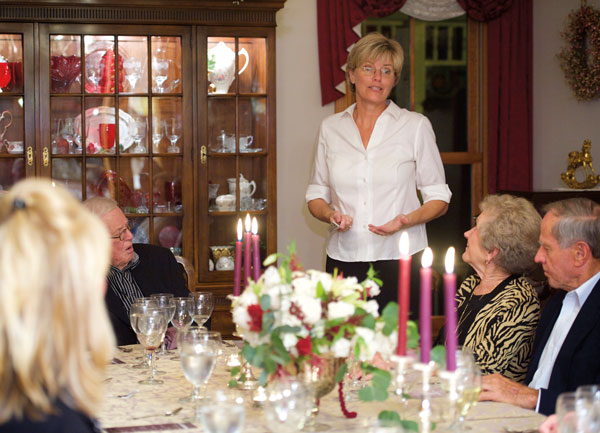 More and more often we go abroad both privately, how business. During our travels, we attend not only official receptions, but it also happens to make new acquaintances and friendships, and thus - it is appropriate to return, when new friends visit Poland. It is natural, that we want to be advantageous during such a visit. This applies to acceptance, which we will publish in honor of the guests, and to the overall appearance of the apartment. I am not thinking of additional investments here, violating the home budget, like those from the memorable series by Jerzy Gruza, "Czter 30olatek”, as well as realized, unfortunately, quite often yet the adage "pledge yourself, and put yourself up”. However, you have to prepare quite carefully for the return visit. Most often we are forewarned about this event quite early, time will be enough, to think over the menu, carefully check your tablecloths and tableware. The setting and decoration of the table should be harmonized with the interior and it is worth putting a particularly strong emphasis on it.
More and more often we go abroad both privately, how business. During our travels, we attend not only official receptions, but it also happens to make new acquaintances and friendships, and thus - it is appropriate to return, when new friends visit Poland. It is natural, that we want to be advantageous during such a visit. This applies to acceptance, which we will publish in honor of the guests, and to the overall appearance of the apartment. I am not thinking of additional investments here, violating the home budget, like those from the memorable series by Jerzy Gruza, "Czter 30olatek”, as well as realized, unfortunately, quite often yet the adage "pledge yourself, and put yourself up”. However, you have to prepare quite carefully for the return visit. Most often we are forewarned about this event quite early, time will be enough, to think over the menu, carefully check your tablecloths and tableware. The setting and decoration of the table should be harmonized with the interior and it is worth putting a particularly strong emphasis on it.
When there is old furniture in the representative room or dining room, a discreetly embroidered or hemstitch tablecloth will look good, old fashioned cutlery and service, e.g. with a silver or gold border. If the apartment is definitely modern, then we cover the table with a colorful tablecloth in a vivid color and combine with it plates and platters made of stoneware or faience, and cutlery with wooden or porcelain handles. With folk accents, wooden plates and platters look good - they can be found in our socialized and cooperative stores - or a very nice service decorated with a Kashubian motif. Of course, for more modern interiors, as probably everyone knows, Traditionally cut crystal glasses or this type of compote do not fit. I warn against this combination - as very blatant. Plain glass without any drawing harmonizes best with the colored cover, but elegant in form, can be colorful: navy blue, smoky or greenish, matching the shade of tablecloths and plates.
Napkins for such an occasion should be linen, or a set with a tablecloth, or ordinary white, stiffly starched, threaded through a special ring (wood, porcelain) or tied with a ribbon. Standing napkin skewers look too much like a dinner in a restaurant. Flowers are indispensable, and not tall cloves, roses or gerberas, but low bouquets of pansies, freesia, climbing roses or daisies, in the autumn, bouquets of freshly picked red rowan look very impressive, hawthorn or barberry. An interesting decoration of the table are "floating bouquets."”. For glass, put a transparent bowl with water right at the base, a cut off large flower of a dahlia or a sunflower or a few unfolded tea roses. The composition can be supplemented with a pretty ivy leaf or a flat floating water lily leaf.
The festive mood is greatly enhanced by candles, but we only put them to dinner and make them dependent on it, what kind of candlestick we have: silver does not match, for a colorful place setting and vice versa - forged iron or faience for old porcelain and cutlery.
What the menu should look like? I get the view often, Polish cuisine is the biggest attraction for foreign guests. Unfortunately, this view holds true only in two cases - if the guest is a representative of the Polish community and there is still a warm place in his memories, dumplings and dumplings or the guest knows our national dishes especially well, and such are few. In all other cases, this theory does not hold, and therefore it will be better, if we prepare dishes without national accents, it is tasty and relatively light. Each of the dishes listed below meets these conditions, except maybe a bread cake, which is high in calories, but so tasty and original, that it inspires the admiration of even the sophisticated French (Checked!). It will be best if we invite guests to dinner (between 2 p.m. and 4 p.m.), tea (between 5 p.m. and 6 p.m.) or dinner (hours later after 6pm).
Here is an example of the order of dishes:
Dinner
1. cold appetizer
2. soup
3. hot starter
4. main course
5. dessert
Tea
1. Cocktail or aperitif, to which we will pass the peanuts, olives, small crackers with vegetable or cheese paste
2. hot snack (very small by volume)
3. tort, coffee or tea, liqueur or cognac
Supper
1. cold snacks
2. hot dishes
3. dessert
4. fruit, coffee, tea
